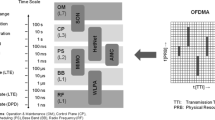Abstract
As the need for mobile services continues to explode, mobile wireless networks must expand greatly their capacities. The capacity of 4G cellular wireless networks like LTE-A (Long Term Evolution Advanced ) can be increased by larger bandwidth, higher number of antennas for more spatial multiplexing, reuse of radio cells and in general optimisation of the network configuration. Methods of capacity expansion divide into three general categories: the deployment of more radio spectrum, more intensive geographic reuse of spectrum and increasing the throughput capacity of each MHz of spectrum within a given geographic area. The paper describes these several basic methods to intensify mobile wireless capacity. The potentially higher capacity will be achieved only if the whole wireless network can be more flexible to the existing real environment at any time. Appropriate linear or nonlinear flexible AMC (adaptive modulation and coding) techniques which are able to identify these changes are described for wideband linear power amplifier, multiple input multiple output antenna systems, heterogeneous networks and self-organising networks including the corresponding realisation and performance aspects.

















Similar content being viewed by others
References
Shannon CE, Weaver W (1949) The mathematical theory of communication. University of Illinois Press, Illinois
Sesia S, Toufik I, Baker M (2011) LTE—the UMTS long term evolution. Wiley, Chichester
Telatar IE (1999) Capacity of multiple-antenna Gaussian channels. Eur Trans Telecommun (ETT) 10:585–595
Bossert M, Haetty B, Klund P (1993) Propagation aspects on railway environment in the GSM frequency range. In: ITG-Fachbericht 124. Informations technische Gesellschaft, Frankfurt, pp 319–330
Cloutier, Stephen R Class E AM transmitter descriptions, circuits, Etc. www.classeradio.com. WA1QIX. Retrieved 6 June 2015 (en.wikipedia.org/wiki/RF_power_amplifier)
MFJ Enterprises Ameritron ALS-1300 1200-watt NO TUNE TMOS-FET AMPLIFIER” (PDF). MFJ Enterprises. Retrieved 6 June 2015. (en.wikipedia.org/wiki/RF_power_amplifier)
Ozalas M (2015) How to design an RF power amplifier: the basics. youtube.com. Retrieved 10 Feb 2015
Fettweis G, Lohning M, Petrovic D, Windisch M, Zillmann P, Rave W (2005) Dirty RF: a new paradigm In: IEEE 16th international symposium on personal, indoor and mobile radio communications, 2005. PIMRC. IEEE, Berlin, Germany
Hätty B et al (2016) EURASIP J Adv Signal Process 2016:19. https://doi.org/10.1186/s13634-016-0310-x
Kenington PB (2000) High-linearity RF amplifier design. Artech House, London
Aschbacher E (2005) Digital pre-distortion of microwave power amplifiers. PhD thesis. Technische Universität Wien, Fakultät für Elektrotechnik and Informationstechnik
Schetzen M (1980) The volterra and wiener theories of nonlinear systems. Wiley, New York
GPP TS 45.005: Technical specification group GSM/EDGE radio access network; radio transmission and reception (Release 12, March 2015). http://www.3gpp.org
Splett A, Dreßler H-J, Fuchs A, Hofmann R, Jelonnek B, Kling H, Koenig E, Schultheiß A (2001) Solutions for highly integrated future generation software radio basestation transceivers. In: IEEE 2001 custom integrated circuits conference, CICC. IEEE, San Diego, USA, 2001
HetNet/Small Cells by Jeanette Wannstrom, masterltefaster.com and Keith Mallinson, WiseHarbor
Dahlman E, Parkvall S, Sköld J (2011) 4G LTE/LTE-advanced for mobile broadband. Academic Press, Oxford
Holma H, Toskala A (2011) LTE for UMTS evolution to LTE-advanced. Wiley, Chichester
Enhanced ICIC for LTEA HetNet, 1998-2011, ZTE Corporation. All rights reserved
GPP TR 36.814: Technical specification group radio access network; Evolved Universal Terrestrial Radio Access (E-UTRA); further advancements for E-UTRA physical layer aspects (Release 9, March 2010). http://www.3gpp.org
EU Project METIS: Mobile and wireless communications enablers for the twenty-twenty information society. https://www.metis2020.com
GPP TS 32.511: Technical specification group services and system aspects; telecommunication management; automatic neighbour relation (ANR) management; concepts and requirements (Release 10, March 2011). http://www.3gpp.org
GPP TR 36.902: Technical specification group radio access network; Evolved Universal Terrestrial Radio Access Network (E-UTRAN); self-configuring and self-optimizing network (SON) use cases and solutions (Release 9, April 2011). http://www.3gpp.org
Acknowledgements
This research is supported by the College of Computing and Informatics-Saudi Electronic University-KSA, Dr. Sri Ram Chandramohan (SEU, KSA), Dr. Dinesh Mavaluru (SEU, KSA), Dr. Azath Mubarakali (KKU, KSA) and my wife-Ranjana Singh.
Author information
Authors and Affiliations
Corresponding author
Rights and permissions
About this article
Cite this article
Singh, A.K. A wireless networks flexible adoptive modulation and coding technique in advanced 4G LTE. Int. j. inf. tecnol. 11, 55–66 (2019). https://doi.org/10.1007/s41870-018-0173-5
Received:
Accepted:
Published:
Issue Date:
DOI: https://doi.org/10.1007/s41870-018-0173-5




